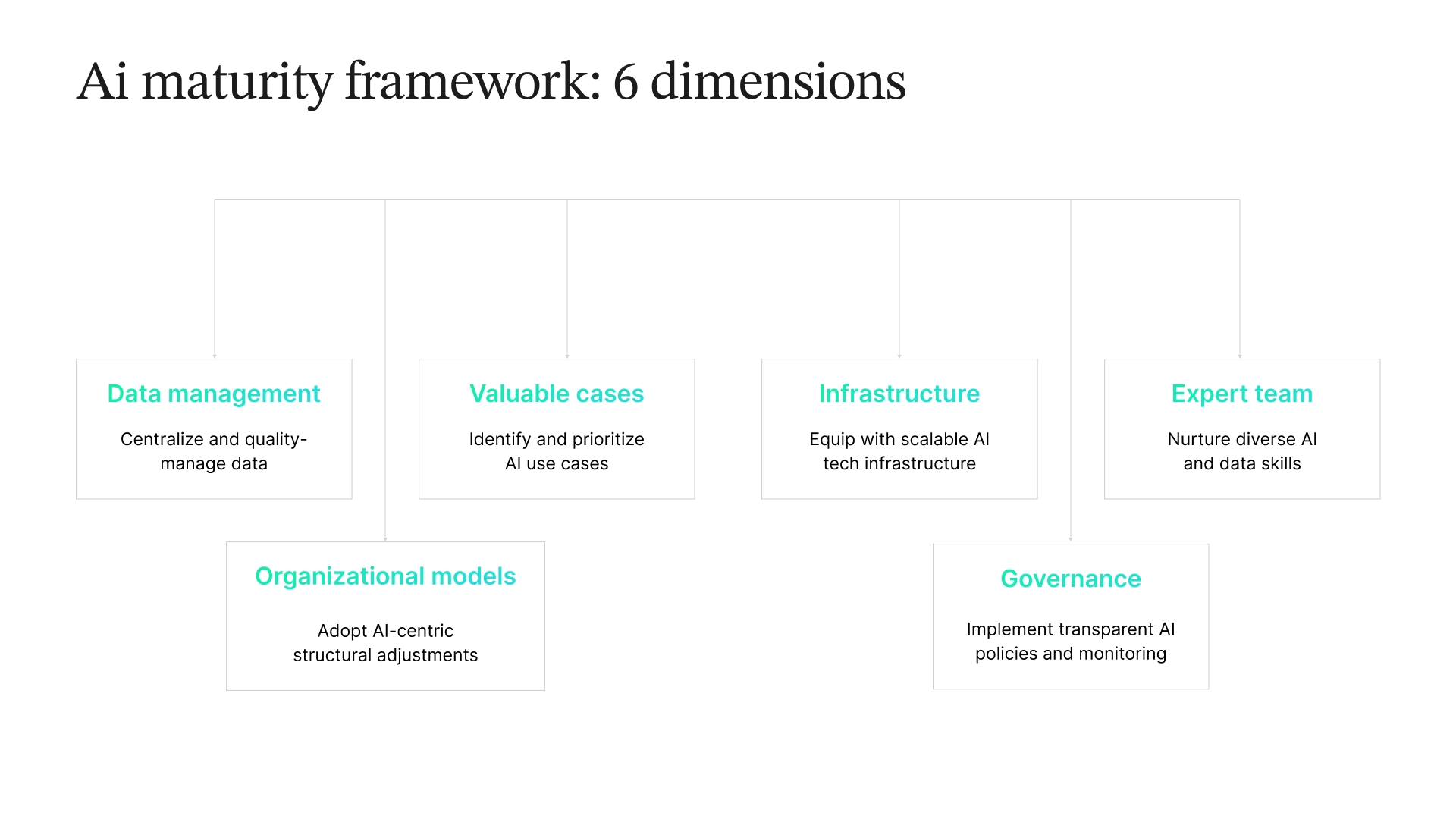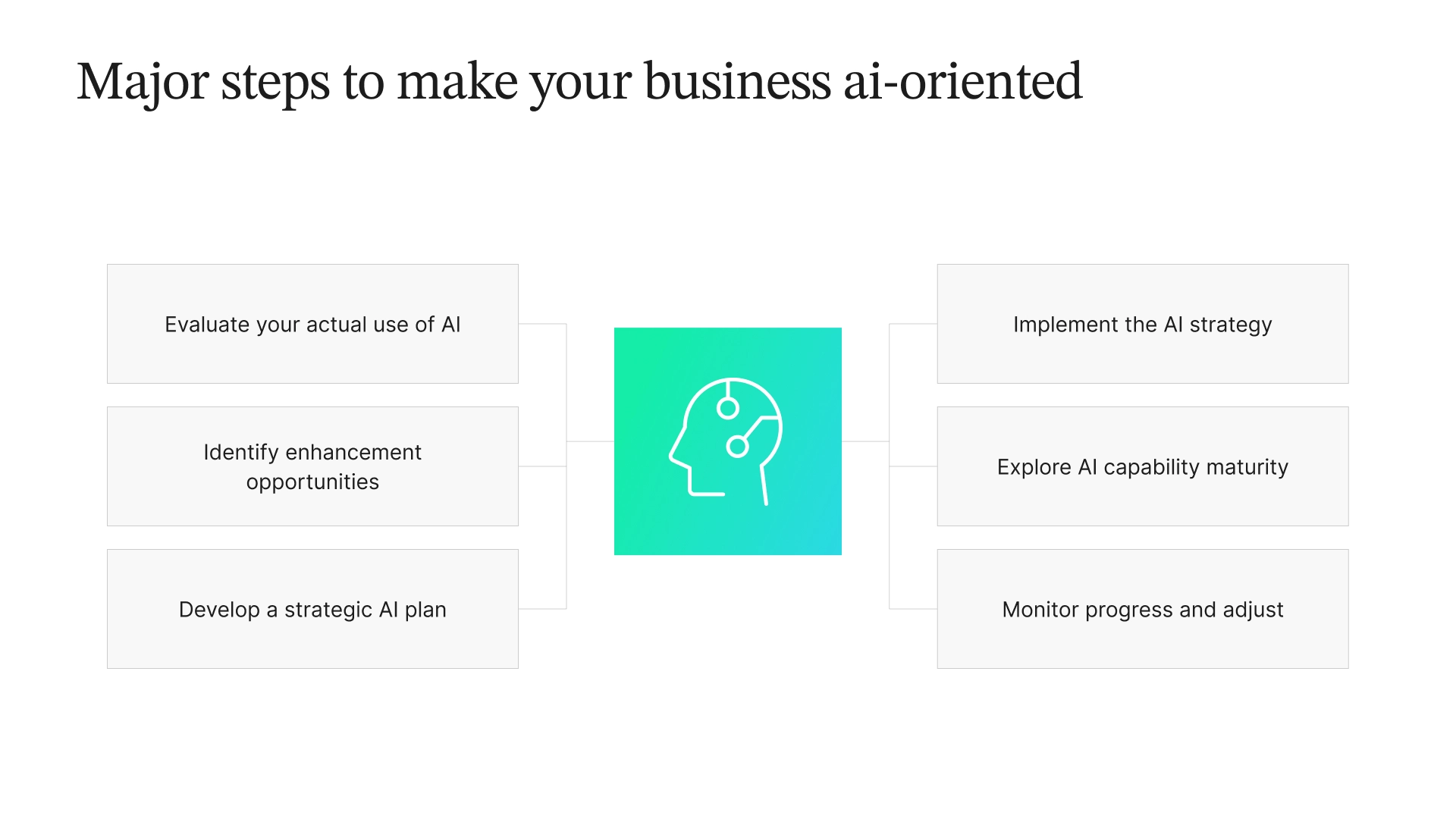Is business-oriented AI truly a game-changer for Small and Medium-sized Enterprises (SMEs)? How big is its impact today? How relevant will it be in 5-10 years? Is my company prepared to embrace this tech? As these questions circle the minds of decision-makers in every industry, the purpose of AI maturity models is to provide clear answers to such queries.
AI is here and it is our responsibility to understand and leverage whatever resources are in our power to boost the efficiency of our businesses. The role of an AI maturity model is to provide a robust framework designed to help businesses evaluate their proficiency in implementing AI technologies and discover areas for growth.
Currently, artificial intelligence is perceived as a crucial megatrend for the upcoming decade. Specifically in Europe, it could lead to productivity boosts ranging from 20% to 38% by 2030. According to a Forbes analysis: logistics, cybersecurity, and healthcare are the top three industries that will benefit from AI applications in the near future.
This is only one of the many reasons why top-tier Business Process Outsourcing (BPO) companies such as Helpware are obligated to explore the concept of AI maturity, so we can aid our partners in this delicate transition. Let’s dive deeper into the notion of AI maturity and its importance for digital-grounded businesses.
The Concept of AI Maturity
AI maturity refers to the capacity of companies to effectively use, adopt, and make the most of AI capabilities. As a company moves through the stages of artificial intelligence maturity, it starts to realize what AI can do for the business internally and externally. This way, it is possible to leverage this data to drive innovation and boost results, both for the company and its clients.
An AI-mature company has a solid plan and vision for bringing artificial intelligence into the fold, plus the resources and know-how to make it happen. In other words, the business already structured what routine activities will be automated, what customer experiences will be optimized, and what might be the perceived qualitative and quantitative benefits, just to mention a few examples.
In order to embark on this fast-paced ride, the first step is to identify, analyze, and solve the company´s inner technical problems, like poor data quality and issues with data-integrating systems. To this day, more than 75% of consumers still worry about receiving false information from artificial intelligence. Integrated tools need to be understood and trusted.
By merging AI into diverse processes and areas of business, companies should be able to work more efficiently, make smarter choices, and improve how they serve their customers. A good starting point for many businesses is deploying the best free AI chat systems, which can automate routine inquiries, freeing up valuable resources for higher-level tasks. Another practical entryway into AI adoption is experimenting with AI product recommendations. These systems can personalize offerings in real-time, enhance user engagement, and drive conversion rates, making them an accessible, high-ROI use case, especially for customer-facing businesses.
AI Maturity Model: Key Dimensions
While there are many paths to accomplishing AI maturity, experts believe that there are, at least, six basic dimensions that managers must consider in developing an AI integration strategy and implementing it as effortlessly as possible.
These key dimensions are:
#1 Leverage data as a strategic asset
Data is a crucial factor for advancing AI maturity in organizations, yet it often presents the biggest operational difficulty. Collecting data is one challenge and ensuring its quality and availability is another story. It’s vital to manage strategically data that is easily accessible to both AI experts and citizen data scientists and maintained across all storage systems.
#2 Add value through experience
Identifying and developing valuable AI real-life uses and applications helps companies understand their capacities and limitations for solving business problems. For example, the adoption of AI ad generators presents a compelling solution for businesses looking to address and solve various challenges. From streamlining content creation processes and enhancing personalization to optimizing ad performance and improving ROI. Organizing these real tests into a roadmap and establishing processes for their selection and prioritization is key for scaling AI initiatives across different business areas.
#3 Build an optimized infrastructure
Designing an organization’s IT infrastructure is key to boosting AI maturity, serving as the technical backbone for AI development. To activate cross-department collaboration and scale services, it’s essential to equip AI experts with the necessary tools and accessibility across the organization for impactful AI solutions through infrastructure.
#4 Nurture a skilled team
Developing a team with the right skills is key to AI maturity. Organizations must focus on teaching AI expertise, ensuring the success of AI initiatives through in-depth training programs, strategic management of data science teams, and the creation of detailed job roles.
# 5 Organize effective processes
The difference between AI leaders and followers often lies in how they’re organized. Successful integration depends on choosing the right organizational model and shifting towards agile methods for project management, significantly enhancing the impact of AI initiatives. The way AI systems and teams blend into the organizational fabric is a critical factor in assessing maturity.
#6 Promote AI governance
AI projects in companies need to establish ground rules, guidelines, and structured procedures for AI’s development and use. These efforts must align with internal policies like data protection, and monitoring AI initiatives’ success to measure their impact. It’s important to keep everything transparent and understandable, especially in sensitive applications.

What Are the Levels of the AI Maturity Model?
As covered above, the AI maturity model is considered a guiding framework that allows companies to measure their AI skills and create a strategic plan for enhancing their AI functions.
This plan emphasizes improving AI skills across four key areas: technology, data, staff, and algorithms. The following models outline the five stages of maturity that every AI-powered company will go through until they achieve mastery in the use of the tool.
Ad Hoc / Aware level
Companies use AI sporadically without a clear plan. This means that they are just beginning to plant the seeds of automatized processes without proper testing or documentation of their results.
Developing level
Businesses start designing and testing a dedicated AI strategy to automate simple actions inside the work funnel. Projects are usually internal and don´t have a direct impact on real client-derived operations.
Mature level
In this phase, the company is already managing a well-tested and approved AI strategy. Managers start to offer this new application to trust-worthy clients, carry out a systematic deployment of a set of automatized actions, and share their insights with real clients.
Leading level
The AI product is fully-mastered and it is solid enough to use it as a value proposition against the company’s direct competitors. Success stories are included in positioning campaigns so the target audience is aware of this attractive core service.
Transformative level
AI is deeply embedded in many or most sectors within the company. Now it has become more than just an innovative product that generates revenue, but has reshaped the core of the business, permeating its model, products, services, and processes.
The AI maturity model includes a scorecard to evaluate a company’s AI strengths in various domains, including data handling, technology, workforce, and policy management.

The Road to AI Advancement: Structured Approach
Understanding and advancing your company’s use of artificial intelligence doesn’t have to be a tough task. At Helpware CX, we are working every day to provide our team members with the proper knowledge to aid our clients in reaching AI maturity at an accelerated pace.
The following AI maturity model offers a clear pathway for organizations to evaluate and enhance their AI capabilities. Here’s how it unfolds in practical steps:
Evaluate your current AI use
Begin by evaluating how your organization currently uses AI. This will be the starting point of your changes as you will understand your current strengths and areas needing attention in AI applications.
Find opportunities for enhancement
Once you know your current AI usage, the next move is to pinpoint where improvements can be made. This involves creating a detailed scorecard. To do this, outline the key areas critical to AI success, set benchmarks for each, evaluate your current standing, and then focus on the areas ready for future development.
Craft a strategic plan
Having determined potential improvement zones, the next step involves creating a strategic plan or roadmap guided by the AI maturity model. This plan should outline specific steps to enhance your AI capabilities, setting realistic targets, timelines, and the resources required for each target area. It’s about moving from where you are to where you want to be in terms of AI use, in a structured and measurable way. Ensure that securing AI systems is a central component of your strategic plan.
Roll out your strategy
The implementation phase is where your planning meets action. Depending on your assessment findings, you may need to adopt new AI technologies, refine your data management practices, or even bring in AI specialists. The goal is to execute the roadmap’s action items, thereby elevating your organization’s AI prowess.
Track and adapt
Progress tracking is vital. Regularly measuring your AI maturity against the set benchmarks allows you to see how far you’ve come and where further adjustments are needed. This ongoing evaluation ensures your AI initiatives remain aligned with your organizational goals and adapt to new challenges and opportunities.
Deep dive into AI capability maturity
Beyond the basics of the AI maturity model, there’s an advanced framework known as the AI Capability Maturity Model. This model offers a more nuanced evaluation of your organization’s AI capabilities across essential domains: data, algorithms, technology, and talent. It’s about understanding not just where you are, but the specific capabilities you need to develop to reach the next level of AI maturity.

Design Your AI-Maturity Framework Today
To wrap it up, the AI maturity framework is a tool that helps companies figure out where they are with AI and what they need to fix to get better. It’s not a one-shot deal; as tech changes and your business grows, you’ll need to keep checking and updating your AI implementation process. This means always learning, staying on top of new AI trends, and using the best practices out there.
AI’s changing the game for businesses big and small, opening up new doors. By looking at all parts of the AI maturity model, you can quickly get the full picture of where you’re at. From there, detecting your weak spots and making a clear plan with specific steps will guide you to level up your AI skills.
Are you ready to embrace AI integration? If so, allow the Helpware experts to guide you through this process, step by step.











